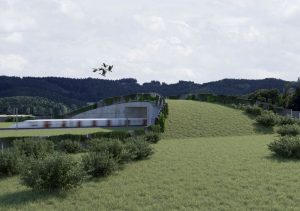The international consulting company Estonian, Latvian & Lithuanian Environment Ltd. (ELLE) has been operating for 22 years and provides consultations to experienced environmental protection specialists in the Baltic States. Evija Skrastiņa, ELLE project manager tells about the company’s investment in the development of the Rail Baltica project.
 What is the role of ELLE in different stages of the Rail Baltica project?
What is the role of ELLE in different stages of the Rail Baltica project?
We have been working with the Rail Baltica project since 2011 and have been involved as environmental consultants in several stages of the project development.
Within the framework of the environmental impact assessment, the most important environmental aspects of this project and conditions for reducing the impacts were identified. The implementation of these requirements is currently ongoing, as we have attracted the best Latvian wildlife experts, and we are monitoring the entire territory of the Rail Baltica route in Latvia. During this monitoring the density and condition of the wildlife population will be identified and assessed until the start of the construction works. Monitoring is also necessary to specify locations for animal or other crossings within the track.
We are also carrying out noise modeling at certain sections of the track and assessing what the current noise level is and what anti-noise measures need to be planned and where in order to ensure compliance with regulatory requirements. In addition, we provide support to international designers, both in communication with environmental authorities and in explaining environmental requirements that may differ from country to country.
What are you currently working on?
We operate throughout the Baltics and the ELLE Group includes companies with offices in Latvia, Estonia and Lithuania. Currently, in cooperation with our Estonian colleagues, we are conducting an environmental impact assessment for the Rail Baltica section in Estonia from Pärnu to the Estonian / Latvian border. We are happy that with our knowledge and experience we can also help our Estonian colleagues because we already implemented a similar project in Latvia in 2015.
How is this project different from others?
This project differs mainly in scale. Only once a century we have the opportunity to participate in the development of new Baltic-wide infrastructure.
How does the experience gained from the Rail Baltica project contribute to the development of the company’s competencies?
Like any large-scale project, the added value here is the experience – both in solving various problems on a larger scale and in cooperation issues. It helps to increase both our knowledge and our capacity. There are several experts involved on our part, in some cases even 10 or more. For example, Rail Baltica is the first transport infrastructure project in Latvia, the implementation of which involves monitoring of wild animals. The Rail Baltica project will be the first in Latvia to build special animal crossings on the track.
Have you attracted additional workers for this project, and how many people work with the Rail Baltica project from your side?
Yes, we have attracted additional help. The number of our employees is growing each month! There is an extensive amount of work within this project, which accordingly requires additional capacity. Currently, we have 5-8 experts involved, as well as we have short-term freelance experts if required by the project activities.
 Could you explain in more detail how the environmental impact of the rail is reduced?
Could you explain in more detail how the environmental impact of the rail is reduced?
To reduce the environmental impact, the work already begins when choosing the location of the route, so that it does not affect and cross any specially protected nature sites. It is vital to remember that the preservation of natural values is as important as the implementation of this infrastructure project. In places where the route will, however, cross important natural sites, such as the northern part of the Salaca Valley, the design task is to find a solution that has the least possible impact on the environment.
The middle part of the route runs along the Kroņi – Dzelve mire, where it is important to preserve and not affect the hydrological state of the mire.
Each location offers different tasks, but the main goal remains the same – to combine protecting nature with the interests of the population and economic interests.
How is the impact of rail on people living near the tracks reduced?
The people living nearby will feel the impact on mobility, as the Rail Baltica route will cross the roads that residents use daily, and the railway will be fenced off for safety reasons. Therefore, it is important to evaluate and implement sufficient solutions to minimize the impact on the mobility of people living near the route. The Rail Baltica route includes two-level road crossings, special crossings for heavy machinery, and crossings for pedestrians and cyclists.
The second aspect is the noise. Rail Baltica will be a new source of noise and to reduce the impact, as well as to ensure that the noise limits are complied with within the residential areas in the vicinity of the track, it is planned to build anti-noise walls or other solutions to reduce the impact.
The construction of the railway will change the existing landscape. A new object will appear where there is currently a forest or field. By engaging landscape architects, designers will need to find balanced solutions for integrating rail into the existing landscape.
And what about animals and birds?
For the animals, as I mentioned before, there will be special crossings – forest bridges for larger animals, so that their natural migration paths are not disturbed and both sides of the main track are connected to avoid the formation of isolated populations.
Regarding birds, in choosing the route, there were micro-restriction areas created that ensured the protection of birds, this way minimizing the point of contact between birds and the railway. Also, in terms of the impact of noise on birds, we are assessing how the noise level currently affects the bird population, how it will affect it during the start of active construction works, and during the operational phase. For example, during the construction phase, work will not be allowed during certain time periods, such as when the birds are nesting. In turn, during the operational phase of the track, experts will have to decide whether to implement noise reduction measures or not and which ones. For example, a noise wall also has its negative effects – the risk of collision. But this will all be taken into consideration and evaluated including the design and type of walls.
What innovations will this project introduce?
For example, due to this project, technical requirements for the design and construction of animal and other crossings will be evaluated and determined in Latvia. Additionally, the project will also show how different solutions can reduce the impact on areas important for birds or how to merge cultural heritage and its preservation with the construction of new infrastructure.
What would be your advice to other companies considering participation in this project?
I would advise not to be afraid of the scale of the project – the project is complex and it is often necessary to find solutions to issues that are new to us, and therefore it presents an additional challenge. Applying for RB Rail AS procurements means to capitalize on the unique opportunity to participate in developing the infrastructure project of the century and to use your knowledge to help achieve the common goal – not only to build a railway line but to also respect the interests of residents, nature, cultural history and other equally important matters.
